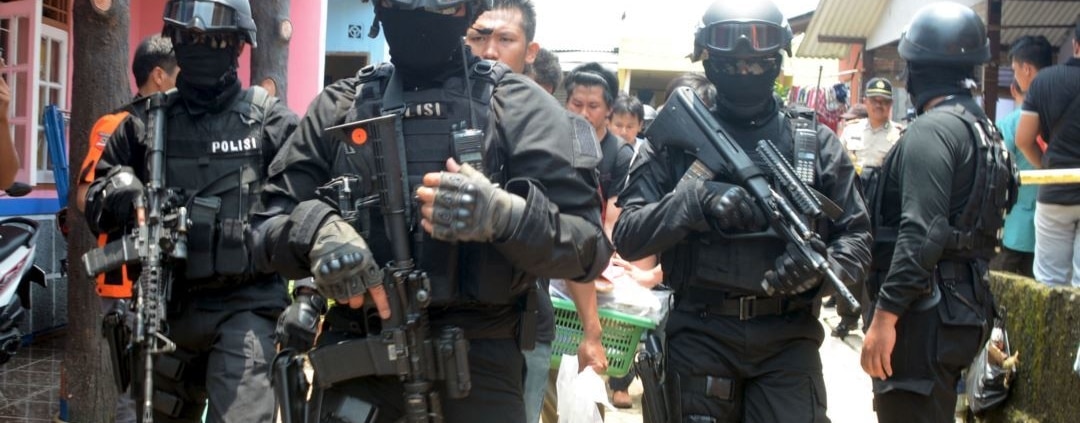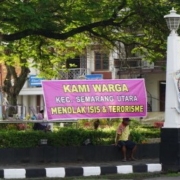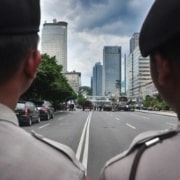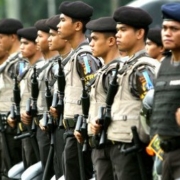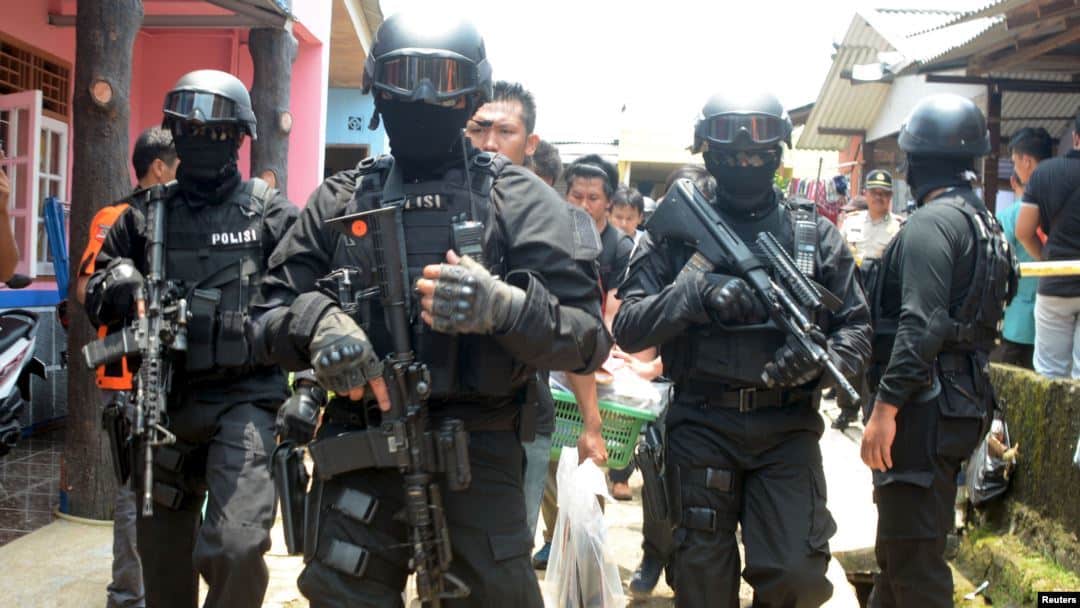
Members of the Indonesian National Police’s counter-terrorism unit, Special Detachment 88 (Densus 88). Photo by Muhammad Iqbal for Antara.
News recently emerged that in March 2020, a Jemaah Islamiyah faction in Banten had planned to conduct a series of robberies (fa’i) targeting shops owned by Indonesian Chinese in Serang (Banten), Tasikmalaya (West Java), and Surabaya (East Java). JI hoped to use the proceeds of these robberies to finance attacks in those cities.
This turned out to be the first time in a decade that JI members were known to have planned an attack in Indonesia. The last attack attributed to JI was the 2009 J.W. Marriott and Ritz Carlton hotel bombings in Jakarta, masterminded by a JI faction led by Malaysian terrorist Noordin M. Top.
What accounts for the re-emergence of JI after such a long absence and what does this mean for the country’s threat level?
‘Jihad later’ policy
Para Wijayanto, who led JI from 2009 until his arrest in May 2019, returned JI to the path it took in the early years of its establishment. That is, reaffirming its commitment to undertaking armed jihad with the long-term goal of establishing an Islamic state in Indonesia.
During Para’s leadership, JI resembled its pre-1999 form, with a focus on i’dad (which militants refer to as preparation for jihad), coupled with an absence of attacks. This was based on the rationale that JI was not militarily ready for jihad and there was a lack of community support for it.
Under Para, JI prepared its military wing by constructing underground bunkers and setting up a home-made weapons factory in Klaten, Central Java, in 2012-2014. It also deployed its members to Syria and Iraq from 2012 to 2017 to train with rebel groups there. Despite its i’dad activities, JI under Para directed its members not to carry out attacks in Indonesia.
Information obtained by the authors on the trials of JI’s key administrators this year have shed light on the group’s tight hierarchical command structure under Para’s leadership. This had kept JI largely unified. Members adhered to the group’s guidelines and leaders’ instructions, and were disciplined if they violated the rules.
The attack plan developed by the JI Banten faction early this year signals, however, that JI’s strict organisational structure seems to have loosened following the arrests of its key leaders. Although Para still has some degree of influence over JI from prison, remote leadership cannot effectively manage the group’s estimated 6,000 members.
Splintering: The legacy of Mantiqi I
As terrorism researcher Solahudin explains in The Roots of Terrorism in Indonesia, the splintering of JI was preceded by several factors. One of these was change in leadership. Following the death of JI’s charismatic founder and leader Abdullah Sungkar in 1999, JI’s Mantiqi I group (Mantiqi I is a geographical division covering Singapore, Malaysia and Southern Thailand), started to carry out operations in the region on its own. Hambali, the leader of Mantiqi I, would later go on to play a key role in the 911 attacks.
The Banten faction that planned the attacks in 2020 is closely linked to Mantiqi I and one of its former members, the executed Bali bomber Imam Samudra, who was a right-hand man to Hambali. Samudra was the pioneer of fa’i in JI. He conducted a robbery of a gold store owned by a Chinese Indonesian in Banten to fund the 2002 Bali bombings, and was assisted by an older brother of the now Banten faction leader. The Banten faction has expressed admiration for Samudra, and aspired to follow his jihad legacy.
In 2016, the Banten faction created a sub-group because of dissatisfaction with the JI leadership. In a repeat of what happened two decades ago, the Banten faction only started to plot an attack after the arrest of JI leaders, indicating that the current JI central command no longer holds a tight grip on its members.
This brings us to the second important factor, which is disagreement on the timing of armed jihad in non-conflict areas. Before communal religious conflicts in Maluku in 1999, Mantiqi I had been a major proponent of waging “jihad now”. That is, it advocated conducting attacks immediately in the region, especially in Indonesia. But JI’s leaders in Mantiqi II (covering the western part of Indonesia) disapproved of the idea, on the grounds that JI was not ready.
Likewise, over recent years, the Banten faction disagreed with JI’s “jihad later” policy under Para, which involved waging attacks only when JI was perceived to be ready both militarily and politically (that is, it had won the hearts and minds of Indonesian Muslims). The faction questioned the purpose of their training if members were not allowed to operationalise it.
The Banten faction also perceives JI as being “too moderate”, likening it to Muhammadiyah and Nahdlatul Ulama, the two largest mainstream Islamic organisations in Indonesia.
What next?
JI’s splintering in Banten portents a possible emergence of more autonomous JI cells with a “jihad now” vision, akin to the pro-Islamic State (IS) group Jamaah Ansharud Daulah (JAD), which has actively conducted attacks in Indonesia over recent years. This will further jeopardise the country’s security landscape, especially if JAD and the Banten faction or other splinter cells decide to collaborate or merge.
This scenario may also depend on who is appointed as successor to Para. It remains to be seen whether Para’s replacement will also continue his “jihad later” policy.
Even if Para’s successor is committed to this path, the next question is whether the new leadership can effectively unite JI. There has always been a risk that the militarily skilled JI personnel could feel that their arduous i’dad will be wasted if it is not used for immediate attacks, as evident in the Banten faction case.
There is also the additional threat from JI foreign fighter returnees, who continue to recruit and train members, thereby transferring military skills gained from their overseas jihad operations.
There is therefore an urgent need for the Indonesian security authorities to counter the threat looming from the splintering of JI.


